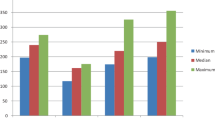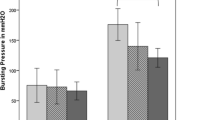Abstract
Background and aims
Anastomotic dehiscence following colorectal surgery is a significant cause of morbidity and mortality. Phenytoin has wound-healing promoting and collagenase inhibitory effects. This study assessed these effects on healing of experimental colonic anastomoses in a rat model.
Materials and methods
Ninety Wistar rats weighing 240–290 g were divided into six groups: 3rd-day control group (n=15), 3rd-day oral administration of phenytoin (n=15), 3rd-day rectal administration of phenytoin (n=15), 7th-day control group (n=15), 7th-day oral administration of phenytoin (n=15), and 7th-day rectal administration of phenytoin (n=15). In oral phenytoin groups the agent was given at 10 mg/kg daily per orogastric route by 4-F fine feeding catheter; in rectal phenytoin RAP groups the agent was administered at 10 mg/0.5 cc daily to the anastomoses transrectally via a fine anal catheter.
Results
There were significantly higher anastomosis bursting pressure values and hydroxyproline contents in phenytoin groups than in controls. In histopathological examination it was seen that phenytoin treatment caused greater collagen deposition, fibroblast, and blood vessel ingrowth than in controls. Immunohistochemical analysis showed the stimulatory effect of phenytoin in expression of vascular endothelial growth factor and basic fibroblast growth factor. Anastomosis bursting pressure, histopathological analysis, hydroxyproline content, and immunohistochemical results were better in the groups with rectal administration than in those with oral administration.
Conclusion
These results had showed us that phenytoin administration resulted in enhanced stability of colonic anastomoses during the first postoperative week and rectal administration showed better results than oral administration.






Similar content being viewed by others
References
Mann B, Kleinschmidt S, Stremmel W (1996) Prospective study of hand-sutured anastomosis after colorectal resection. Br J Surg 83:29–31
Pakkastie TE, Luukkonen PE, Jarvinen HJ (1994) Anastomotic leakage after anterior resection of the rectum. Eur J Surg 160:293–297
Schrock TR, Deveney CW, Dunphy JE (1973) Factor contributing to leakage of colonic anastomoses. Ann Surg 177:513–518
Bosi G, Evangelisti R, Valeno V, Carinci F, Pezzetti F, Calastrini C (1998) Diphenylhydantoin affects glycosaminoglycans and collagen production by human fibroblasts from cleft palate patients. J Dent Res 77:1613–1621
Goebel RW (1972) Sodium diphenylhydantoin association with oral healing. J Oral Surg 30:191–195
DaCosta M, Regan M, Sader M, Leader M, Bouchier-Hayes D (1998) Diphenylhydantoin sodium promotes early and marked angiogenesis and results in increased collagen deposition and tensile strength in healing wounds. Surgery 123:287–293
Shafer WG (1961) Effect of dilantin sodium analogues on cell prolipheration in tissue culture. Proc Soc Exp Biol Med 106:205–209
Kolbert GS (1968) Oral diphenylhydantoin in corneal wound healing in the rabbit. Am J Ophthalmol 66:736–738
Syk I, Agren MS, Adawi D, Jeppsson B (2001) Inhibition of matrix metalloproteinases enhances breaking strength of colonic anastomoses in an experimental model. Br J Surg 88:228–234
Ehrlich HP, Tarver H, Hunt TK (1973) Effects of vitamin A and glucocorticoids upon inflammation and collagen synthesis. Ann Surg 177:222–227
Yamamoto T, Keighley MR (1999) Stapled functional end-to-end anastomosis in Crohn's disease. Surg Today 29:679–681
Goligher JC, Graham NG, De Dombal FT (1970) Anastomotic dehiscence after anterior resection of rectum and sigmoid. Br J Surg 57:109–118
Jiborn H, Ahonen J, Zederfeld B (1980) Healing of experimental colonic anastomoses collagen metabolism in the colon after left colon resection. Am J Surg 139:398–405
Narayanan AS, Meyers DF, Page RC (1988) Regulation of collagen production in fibroblasts cultured from normal and phenytoin-induced hyperplastic human gingiva. J Periodontal Res 23:118–121
Talas G, Brown RA, McGrouther DA (1999) Role of phenytoin in wound healing-a wound pharmacology perspective. Biochem Pharmacol 57:1085–1094
Moy LS, Tan EM, Holness R, Uitto J (1985) Phenytoin modulates connective tissue metabolism and cell proliferation in human skin fibroblast cultures. Arch Dermatol 121:79–83
Ferrara N, Henzel WJ (1989) Pituitary follicular cells secrete a novel heparin-binding growth factor specific for vascular endothelial cells. Biochem Biophys Res Commun 161:851–858
Kandel J, Bossy-Wetzel E, Radvanyi F, Klagsbrun M, Folkman J, Hanahan D (1991) Neovascularization is associated with a switch to the export of bFGF in the multistep development of fibrosarcoma. Cell 66:1095–1104
Grant M, Jerdan J, Merimee TJ (1987) Insulin-like growth factor-I modulates endothelial cell chemotaxis. J Clin Endocrinol Metab 65:370–371
Dignass AU, Tsunekawa S, Podolsky DK (1994) Fibroblast growth factors modulate intestinal epithelial cell growth and migration. Gastroenterology 106:1254–1262
Folkman J, Szabo S, Stovroff M, McNeil P, Li W, Shing Y (1991) Duodenal ulcer. Discovery of a new mechanism and development of angiogenic therapy that accelerates healing. Ann Surg 214:414–425
Ziche M, Morbidelli L, Choudhuri R, Zhang HT, Donnini S, Granger HJ (1997) Nitric oxide synthase lies downstream from vascular endothelial growth factor-induced but not basic fibroblast growth factor-induced angiogenesis. J Clin Invest 99:2625–2634
Hawley PR, Faulk WP, Hunt TK, Dunphy JE (1970) Collagenase activity in the gastro-intestinal tract. Br J Surg 57:896–900
Delaney P, Lalor D (1976) Enzyme inhibition in colorectal surgery. Br J Surg 63:23–24
Young HL, Wheeler MH (1983) Effect of intravenous aprotinin (Trasylol) on the healing of experimental colonic anastomoses in the rabbit. Eur Surg Res 15:18–23
Lerner U, Hanstrom L (1980) Influence of diphenylhydantoin on lysosomal enzyme release during bone resorption in vitro. Acta Pharmacol Toxicol (Copenh) 47:144–150
Acknowledgements
This study was carried out in the Research Laboratories of the Faculty of Medicine, Cumhuriyet University, in Sivas, Turkey, and was supported by the Cumhuriyet University Research Foundation.
Author information
Authors and Affiliations
Corresponding author
Rights and permissions
About this article
Cite this article
Turan, M., Unver Saraydin, S., Canbay, E. et al. Positive effects of phenytoin on experimental colonic anastomoses. Int J Colorectal Dis 19, 250–257 (2004). https://doi.org/10.1007/s00384-003-0533-9
Accepted:
Published:
Issue Date:
DOI: https://doi.org/10.1007/s00384-003-0533-9




